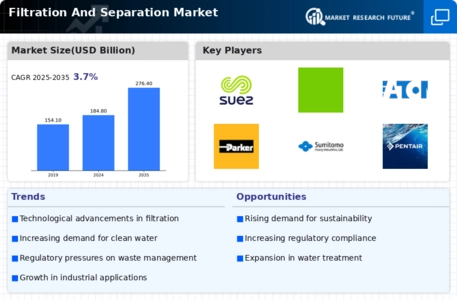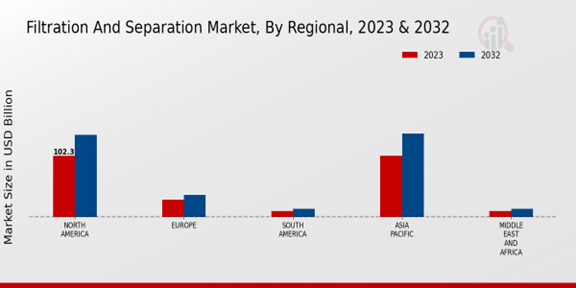Market Growth Projections
The Global Filtration And Separation Market Industry is poised for substantial growth, with projections indicating a market size of 184.8 USD Billion in 2024 and an anticipated rise to 276.4 USD Billion by 2035. This growth trajectory suggests a compound annual growth rate (CAGR) of 3.73% from 2025 to 2035. Various factors, including increasing demand for clean water, regulatory compliance, and technological advancements, are driving this expansion. The market's evolution reflects a broader trend towards sustainability and efficiency in filtration processes, as industries seek innovative solutions to meet environmental and health standards. This growth presents opportunities for stakeholders across the filtration and separation landscape.
Growth in Industrial Applications
The Global Filtration And Separation Market Industry is experiencing substantial growth due to the increasing adoption of filtration solutions across diverse industrial applications. Industries such as chemicals, pharmaceuticals, and food and beverage are increasingly relying on advanced filtration technologies to ensure product quality and compliance with safety standards. For instance, the pharmaceutical sector utilizes filtration systems to remove contaminants and ensure the purity of products. This trend is expected to contribute significantly to market growth, as industries prioritize quality assurance and regulatory compliance. The anticipated increase in market size to 276.4 USD Billion by 2035 underscores the importance of filtration in maintaining industry standards.
Increasing Demand for Clean Water
The Global Filtration And Separation Market Industry is witnessing a surge in demand for clean and safe drinking water, driven by growing population and urbanization. As water scarcity becomes a pressing issue, governments and organizations are investing in advanced filtration technologies. For instance, the global market is projected to reach 184.8 USD Billion in 2024, reflecting the urgent need for effective water treatment solutions. This trend is particularly evident in developing regions, where access to clean water is limited. Consequently, the industry is likely to experience robust growth as innovative filtration systems are adopted to meet regulatory standards and consumer expectations.
Rising Awareness of Health and Safety
Growing awareness of health and safety concerns is driving the Global Filtration And Separation Market Industry, particularly in the context of air and water quality. Consumers and industries alike are becoming more conscious of the impact of pollutants on health, prompting a shift towards cleaner technologies. This heightened awareness is reflected in the increasing demand for air filtration systems in residential and commercial settings, as well as advanced water treatment solutions. As the market evolves, it is likely to see a continued emphasis on health and safety, leading to innovations in filtration technologies that cater to these concerns. This trend is expected to bolster market growth, contributing to the projected increase in market size.
Regulatory Compliance and Environmental Concerns
Regulatory frameworks aimed at ensuring environmental protection are significantly influencing the Global Filtration And Separation Market Industry. Stricter regulations regarding wastewater treatment and emissions control compel industries to adopt advanced filtration technologies. For example, the implementation of the Clean Water Act in various countries mandates the treatment of industrial effluents before discharge. This regulatory pressure not only drives the demand for filtration solutions but also encourages innovation in separation technologies. As a result, the market is expected to grow steadily, with projections indicating a rise to 276.4 USD Billion by 2035, as industries seek to comply with evolving environmental standards.
Technological Advancements in Filtration Technologies
Technological innovations are reshaping the Global Filtration And Separation Market Industry, leading to the development of more efficient and cost-effective filtration solutions. Advancements such as membrane filtration, nanotechnology, and automated filtration systems enhance the performance and reliability of filtration processes. These technologies not only improve separation efficiency but also reduce operational costs for industries. As a result, the market is likely to expand, with a projected compound annual growth rate (CAGR) of 3.73% from 2025 to 2035. The integration of smart technologies into filtration systems further enhances their appeal, driving adoption across various sectors, including pharmaceuticals, food and beverage, and water treatment.








